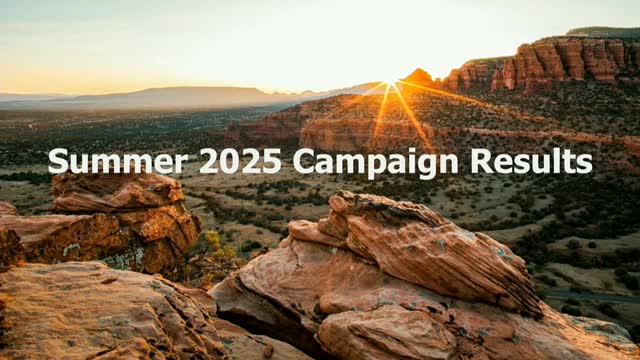Sedona tourism staff report $2.5M estimated impact from summer campaign; ROAS 12:1 and winter plan includes high‑income test
October 01, 2025 | Sedona, Yavapai County, Arizona
This article was created by AI summarizing key points discussed. AI makes mistakes, so for full details and context, please refer to the video of the full meeting. Please report any errors so we can fix them. Report an error »

Tourism program staff presented summer campaign results and a proposed winter campaign allocation to the Tourism Advisory Board, reporting a 12-to-1 return on ad spend (ROAS) from attribution tracking and an estimated $2.5 million in economic impact tied to the campaign.
The presenter said Datafy remains the city's chosen attribution vendor because, among other reasons, it can map ad visits to points of interest and deliver near‑real-time reporting. The presenter said the summer campaign produced more than 4.2 million impressions across channels, and that the 12:1 ROAS yielded an estimated $123,000 in sales and bed tax for the city. "That 12 to 1 return on investment meant that we saw over $2,500,000 in economic impact," the presenter said.
Staff and the marketing partner DVA reviewed which channels delivered visits that were later observed in market. The board heard that connected-TV (CTV) performed better than expected for attribution, nearing parity with web ads, and that the destination attracted a higher-share audience with household incomes above $150,000 (22 percent of attributed visitors). The presenter said average daily rates and length of stay differed by lodging type: hotels’ average length of stay rose slightly and short-term rentals had higher average stays.
The winter campaign recommendation being taken to council would raise the program’s per‑visitor target to $2.50 and includes a pilot test that focuses advertising to households with incomes of $250,000 and higher. The presenter said staff will cap attribution windows as they do now and will monitor results over an extended period; one board member recommended keeping the test open for nine months to capture longer booking windows for higher‑income travelers.
Why it matters: staff said advertising attribution is becoming more difficult as device-based tracking declines, so now is the time to test targeted strategies while attribution still yields actionable data. Board members stressed that email marketing lists remain a valuable, low-cost channel and urged more incentives to grow the city’s opt‑in lists.
Board members asked about spend breakdowns and vendor selection; the presenter said an agency review found Datafy still best matched the city’s need for point‑of‑interest attribution and real‑time feeds, though staff plan to keep a second vendor as a reserve if attribution capture declines.
Ending: Staff said they will present the winter campaign funding request to council on Oct. 14 and will publish fuller August research, including credit‑card spend data, in the tourism business newsletter next week.
The presenter said Datafy remains the city's chosen attribution vendor because, among other reasons, it can map ad visits to points of interest and deliver near‑real-time reporting. The presenter said the summer campaign produced more than 4.2 million impressions across channels, and that the 12:1 ROAS yielded an estimated $123,000 in sales and bed tax for the city. "That 12 to 1 return on investment meant that we saw over $2,500,000 in economic impact," the presenter said.
Staff and the marketing partner DVA reviewed which channels delivered visits that were later observed in market. The board heard that connected-TV (CTV) performed better than expected for attribution, nearing parity with web ads, and that the destination attracted a higher-share audience with household incomes above $150,000 (22 percent of attributed visitors). The presenter said average daily rates and length of stay differed by lodging type: hotels’ average length of stay rose slightly and short-term rentals had higher average stays.
The winter campaign recommendation being taken to council would raise the program’s per‑visitor target to $2.50 and includes a pilot test that focuses advertising to households with incomes of $250,000 and higher. The presenter said staff will cap attribution windows as they do now and will monitor results over an extended period; one board member recommended keeping the test open for nine months to capture longer booking windows for higher‑income travelers.
Why it matters: staff said advertising attribution is becoming more difficult as device-based tracking declines, so now is the time to test targeted strategies while attribution still yields actionable data. Board members stressed that email marketing lists remain a valuable, low-cost channel and urged more incentives to grow the city’s opt‑in lists.
Board members asked about spend breakdowns and vendor selection; the presenter said an agency review found Datafy still best matched the city’s need for point‑of‑interest attribution and real‑time feeds, though staff plan to keep a second vendor as a reserve if attribution capture declines.
Ending: Staff said they will present the winter campaign funding request to council on Oct. 14 and will publish fuller August research, including credit‑card spend data, in the tourism business newsletter next week.
View full meeting
This article is based on a recent meeting—watch the full video and explore the complete transcript for deeper insights into the discussion.
View full meeting
